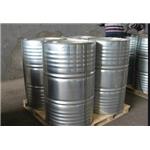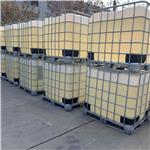Chemical Properties
White lustrous plates or leaflets. Soluble in alcohol and ether; very slightly soluble
in water. Combustible.
Chemical Properties
p-Toluidine is a colorless solid.
Uses
p-Toluidine is an intermediate in the production of dyes, organic chemicals and aromatic azo compounds. It serves as a component of accelerators for cyanoacrylate glues. Furthermore, it acts as a bidentate Schiff base ligand through condensation with salicylaldehyde. It reacts with catecholamine to form a dye which is useful for spectrophotometric determination of catecholamine drugs.
Uses
p-Toluidine is used as an intermediate in themanufacture of various dyes. It is also usedas a reagent for lignin and nitrites.
Uses
Manufacture of various dyes and other organic chemicals. o-Isomer also in printing textiles blue black; making colors fast to acids. p-Isomer also as a reagent for lignin, nitrite, phloroglucinol.
Definition
ChEBI: An aminotoluene in which the amino substituent is para to the methyl group.
General Description
Colorless solid. Melting point 44°C (111°F). Specific gravity 1.046. Vapor heavier than air. Produces toxic oxides of nitrogen during combustion. May be absorbed through the skin. Used in dyes, and in organic chemical manufacturing.
Reactivity Profile
p-Toluidine neutralizes acids to form salts plus water in exothermic reactions. May be incompatible with isocyanates, halogenated organics, peroxides, phenols (acidic), epoxides, anhydrides, and acid halides. Flammable gaseous hydrogen is generated in combination with strong reducing agents, such as hydrides. Can react vigorously with oxidizing reagents. Emits very toxic fumes of oxides of nitrogen when heated to decomposition. Hypergolic reaction with red fuming nitric acid [Kit and Evered, 1960, p. 239, 242].
Health Hazard
Absorption of toxic quantities by any route causes cyanosis (blue discoloration of lips, nails, skin); nausea, vomiting, and coma may follow. Repeated inhalation of low concentrations may cause pallor, low-grade secondary anemia, fatigability, and loss of appetite. Contact with eyes causes irritation.
Health Hazard
p-Toluidine is a mild to moderate irritanton the skin. The irritant effect on rabbits’eyes was strong. The toxic properties ofp-toluidine are similar to its ortho- and meta isomers and aniline. The clinical signs of tox icity are methemoglobinemia, anemia, andcyanosis. The major metabolite in urine afteroral application in male rats was 2-amino-5-methylphenol, which was excreted alongwith 3.5% unchanged p-toluidine (ACGIH1986). Exposure to 40-ppm concentrationfor 1 hour resulted in severe poisoning inhumans.
Fire Hazard
Special Hazards of Combustion Products: Toxic and flammable vapors may form in fire.
Safety Profile
Confirmed carcinogen.
Poison by ingestion and intraperitoneal
routes. Mutation data reported. A severe
skin and eye irritant. Flammable when
exposed to heat, flame, or oxidizers. Can
react vigorously on contact with oxidzing
materials. To fight fire, use foam, CO2, dry
chemical. When heated to decomposition it
emits highly toxic fumes of NOx. See also o-
TOLUIDINE and ANILINE.
Potential Exposure
para-Toluidine is used in dyes, and in organic chemical manufacturing
Carcinogenicity
In an 18-month p-toluidine hydrochloride diet carcinogenicity
study, maleCDrats (1000 and 2000 ppmfor 18 months)
did not develop statistically significant increases of tumors;
however,CD-1male and female mice (1000 ppmfor 6 months
and then 500 ppmfor additional 12 months; or 2000 ppm for 6
months and then 1000 ppm for additional 12 months) showed
significant increases in liver carcinomas: in males at both dose
levels and in females at the high dose level.
Shipping
UN3451 Toluidines, solid, Hazard Class: 6.1; Labels: 6.1-Poisonous materials
Purification Methods
In general, methods similar to those for purifying aniline can be used. It can be separated from the o-and m-isomers by fractional crystallisation from its melt. p-Toluidine has been crystallised from hot water (charcoal), EtOH, *benzene, pet ether or EtOH/water (1:4), and dried in a vacuum desiccator. It can also be sublimed at 30o under vacuum. For further purification, use has been made of the oxalate, the sulfate and acetylation. The oxalate, formed as described for o-toluidine, is filtered, washed and recrystallised three times from hot distilled water. The base is regenerated with aqueous Na2CO3 and recrystallised three times from distilled water. [Berliner & May J Am Chem Soc 49 1007 1927.] Alternatively, p-toluidine is converted to its acetyl derivative which, after repeated crystallisation from EtOH, is hydrolysed by refluxing (50g) in a mixture of 500mL of water and 115mL of conc H2SO4 until a clear solution is obtained. The amine sulfate is isolated, suspended in water, and NaOH is added. The free base is distilled twice from zinc dust under vacuum. The p-toluidine is then recrystallised from pet ether and dried in a vacuum desiccator or in a vacuum for 6hours at 40o. The benzoyl derivative has m 158o (from EtOH). [Berliner & Berliner J Am Chem Soc 76 6179 1954, Moore et al. J Am Chem Soc 108 2257 1986, Beilstein 12 H 880, 12 I 140, 12 II 482, 12 III 2017, 12 IV 1866.]
Incompatibilities
para-Toluidine is incompatible with oxidizers (chlorates, nitrates, peroxides, permanganates, perchlorates, chlorine, bromine, fluorine, etc.); contact may cause fires or explosions. Keep away from alkaline materials, strong bases, strong acids, oxoacids, epoxides. p-Toluidine neutralizes acids to form salts plus water in exothermic reactions. May be incompatible with isocyanates, halogenated organics, peroxides, phenols (acidic), epoxides, anhydrides, and acid halides. Flammable gaseous hydrogen is generated in combination with strong reducing agents, such as hydrides. Hypergolic reaction with red fuming nitric acid
Toxics Screening Level
The initial threshold screening level (ITSL) for p-Toluidine is 0.03 μg/m3 based on an annual averaging time.
Waste Disposal
Consult with environmental regulatory agencies for guidance on acceptable disposal practices. Generators of waste containing this contaminant (≥100 kg/mo) must conform with EPA regulations governing storage, transportation, treatment, and waste disposal. Controlled incineration (oxides of nitrogen are removed from the effluent gas by scrubbers and/or thermal devices).






